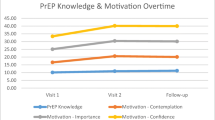Abstract
Reducing HIV transmission is a critical goal worldwide, prompting new strategies to slow the spread of the virus. This paper describes the theoretical underpinnings of the Comprehensive Harm Reduction Protocol (CHRP) and the process of its implementation in one large urban HIV clinic and two smaller rural primary care clinics. Patients enrolled in CHRP complete the Risk Diagnostic Questionnaire (RDQ), self-reporting HIV transmission risk behavior at most clinic visits. Clinicians review RDQs to trigger dialogue using motivational interviewing and the stages of health behavior change to reduce high-risk behaviors (drug use, alcohol use, or high-risk sexual behavior). In the ongoing evaluation study, CHRP patients receive two provider-only visits before being randomized to continue with provider brief prevention messages only or to receive additional intensive counseling with a risk-reduction specialist following the provider visit. If outcome data support one or both interventions, CHRP could be a useful model for widespread adoption. Observations from the implementation of this protocol are presented in order to facilitate the adoption of this protocol in interested clinics. Later, results of the evaluation of the implementation of the protocol may have value in developing prevention policy in HIV treatment clinics.

Similar content being viewed by others
References
Cifuentes, M., Fernald, D. H., Green, L. A., Niebauer, L. J., Crabtree, B. F., Stange, K. C., & Hassmiller, S. B. (2005). Prescription for health: Changing primary care practice to foster healthy behaviors. Annals of Family Medicine, 3(Suppl 2), S4–S11.
Cohen, D., McDaniel, R. R. Jr., Crabtree, B. F., Ruhe, M. C., Weyer, S. M., Tallia, A., et al. (2004). A practice change model for quality improvement in primary care practice. Journal of Healthcare Management, 49(3), 155–168.
Crabtree, B. F., Miller, W. L., Tallia, A. F., Cohen, D. J., DiCicco-Bloom, B., McIlvain, H. E., et al. (2005). Delivery of clinical preventive services in family medicine offices. Annals of Family Medicine, 3(5), 430–435.
Gibson, D. R., Hudes, E. S., & Donovan, D. (1999). Estimating and correcting for response bias in self-reported risk behavior. Journal of Sex Research, 36, 95–101.
Jaén, C. R., Stange, K. C., & Nutting, P. A. (1994). Competing demands and primary care: A model for the delivery of clinical preventive services. Journal of Family Practice, 38(2), 166–171.
Kalichman, S. C., Rompa, D., & Cage, M. (2005) Group intervention to reduce HIV transmission risk behavior among persons living with HIV/AIDS. Behavior Modification, 29(2), 256–285.
Kuenneth, C. A., Flynn, N. M., Clancy, L., Callahan, E. J., DaValle, L., Enders, S. R., et al. (2005). Poster: Screening for HIV-transmission risk: Does urban versus rural location of care matter? CDC Conference on HIV Prevention, Atlanta.
Marlatt, G. A., & Witkiewitz, K. (2002). Harm reduction approaches to alcohol use: Health promotion, prevention, and treatment. Addictive Behaviors, 27(6), 867–886.
Miller, W. R., & Rollnick S. (2002). Motivational interviewing: Preparing people for change (2nd ed), New York, NY, US: Guilford Press.
Platt, F. W., Gaspar, D. L., & Coulehan, J. L. et al. (2001). ‘Tell me about yourself’: The patient-centered interview. Annals of Internal Medicine, 134(11), 1079–1085.
Prochaska, J. O., & DiClemente, C. C. (1982). Transtheoretical therapy: Toward a more integrative model of change. Psychotherapy: Theory, Research & Practice, 19(3), 276–288.
Prochaska, J. O., DiClemente, C. C., & Norcross, J. (2005). The transtheoretical approach. In: M. Goldfried (Ed.), Handbook of psychotherapy integration (2nd ed). New York, NY, US: Oxford University Press, 147–171. .
Richardson, J. L., Milam J., McCutchan A., Stoyanoff, S., Bolan, R., Weiss, J., et al. (2004). Effect of brief safer-sex counseling by medical providers to HIV-1 seropositive patients: a multi-clinic assessment. AIDS, 18, 1179–1186.
Skinner, B. F. (1969). Contingencies of reinforcement: A theoretical analysis. New York: Appleton-Century-Crofts,Century Psychology Series.
Author information
Authors and Affiliations
Corresponding author
Rights and permissions
About this article
Cite this article
Callahan, E.J., Flynn, N.M., Kuenneth, C.A. et al. Strategies to Reduce HIV Risk Behavior in HIV Primary Care Clinics: Brief Provider Messages and Specialist Intervention. AIDS Behav 11 (Suppl 1), 48–57 (2007). https://doi.org/10.1007/s10461-006-9200-9
Received:
Accepted:
Published:
Issue Date:
DOI: https://doi.org/10.1007/s10461-006-9200-9




